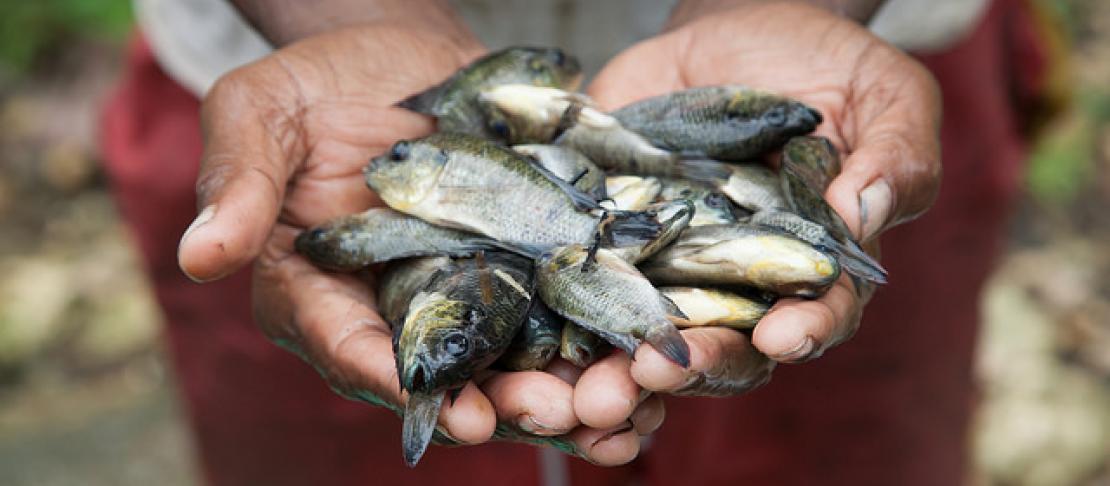Supporting small-scale fish farms for climate risk management in Nyando

Farmers take on fish farming to generate income and manage climate risks.
Through training in innovative farm technologies and practices supported by the CGIAR Research Program on Climate Change, Agriculture and Food Security (CCAFS) and its partners, farmers have learnt the practice of fish farming as part of the climate-smart farming component.
Fish farming on smart farms
In addition to income generation, fish farming has other benefits such as improving communities' nutritional value and reducing pressure exerted by fishermen on the nearby Lake Victoria. The Departments of Fisheries from both Kisumu and Kericho Counties are working with farmers in Nyando to promote the enterprise in three smart farms, namely, Onyuongo, Lower Kamula and Obinju. These smart farms are managed by youth and women groups. With support from CCAFS, mini earth dams with capacity of 300,000 liters were constructed by these groups in their respective smart farms purposely for irrigation, and then fishing was introduced in 2014 as an additional income-generating activity. These smart farms serve as learning sites where, through organized learning events such as field days and exchange visits, farmers come together to learn and acquire aquaculture skills which include site selection, water quality, pond construction, stocking rate, feeding, predators, harvesting techniques, preservation and marketing, as well as book-keeping. Besides fish farming, other cross-cutting issues including HIV/AIDS awareness, gender responsiveness and the need for adaptation of improved methodologies in crop production and livestock keeping are also emphasized.
A number of individual famers have stocked their water dams with fish and they use locally available feeds that are affordable, such as potato vines and some of them have already started harvesting. John Obuom is one of them, a father of twelve and owns one acre of land. Initially, he was only cultivating crops but he could not harvest enough to cater for his family’s needs, but now he is a happy man as he is earning a respectable livelihood by harvesting catfish from his mini earthen pond constructed in 2016. With the kind of technical training that he acquired, John is confident of competing with those who are employed in making a decent livelihood for his family out of fish farming. Like many in the rural areas, John was willing to try his hand at anything that would have given him a better livelihood. Despite the efforts he put in farming, he never got enough income to cater for his family due to his small size of land and ever changing weather patterns that affected crop production. However, things changed when he introduced fish farming in his two water pans with combined capacity of 120,000 liters.
I had never thought of fish farming as one of the best enterprise I could venture in. I developed interest when the county government department of fisheries and Thin Qubator through CCAFS project introduced fish component under climate smart farms in 2014. We were trained through demonstrations and I discovered that it was profitable than other farming enterprises and also did not require a lot of land to do it. Furthermore, once the pond is constructed, you only require cleaning it before you introduce another lot. I decided to try it in my own farm and the first harvest gave me a profit of USD500, but this increased to USD1000 in the second harvest since the construction costs were not included,” John Obuom said.
The success in fish farming has increased John’s income that he now believes that he does not need to migrate from his village in search of employment to the cities to feed his children and pay their school fees. He is now planning to construct two more ponds where he will raise tilapia and would like to start processing of fish to make it more valuable.
Fish farming for the future
The local fish demand remains higher as compared to the supply, and upscaling of the fish farming intervention is being planned through partnership with the private sector, and Kisumu and Kericho County Departments of Fisheries. Currently, at least 1,000 farmers across Nyando region have acquired trainings in fish farming. A total of 50 individual farmers have already ventured into the business and it is hoped that the scaling up process will see at least 300 farmers establishing fish ponds on their farms by the end of 2018. There is a plan to establish a semi-intensive fish hatchery centre where high quality fingerlings of tilapia and catfish will be produced through a net enclosure system and later introduced into individual farmers ponds. This project aims at producing over 200,000 fingerlings of tilapia and catfish every quarter of the year, to satisfy local demand, and this is envisaged to earn farmers a total income of at least USD 400,000 annually.
John Recha is a Post Doctoral Fellow with CCAFS East Africa.

